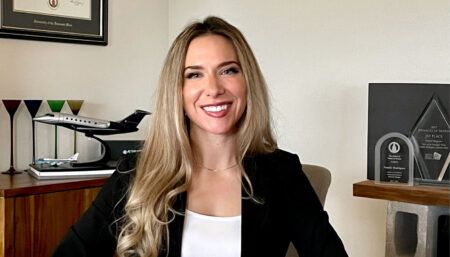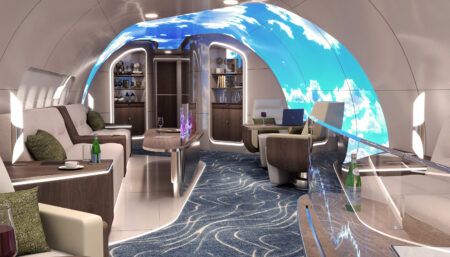Rick Roseman of RWR Designs analyses the finer details of delivering custom VIP interiors on time and within budget
In the world of engineering, certification and design, the devil is in the detail. Out of this truth was born the concept of E-First. To conceive a beautiful interior that fits the functional and aesthetic criteria of your client is one thing, but to get it built, installed and delivered as a final in-service aircraft is quite another. It is a monumental undertaking to combine all the necessary disciplines and involved entities and then convert a raw customer-approved design spec, renderings, initial CADs and so on into a working set of buildable construction documents.
Sooner or later, three parties – the designer, the certification authority and the engineering group – are going to be joined at the hip in this endeavour and will have to work very closely and cooperatively over many months to make it happen. In most cases, but not all, the engineering group is integral to the completion centre. Similarly designated engineering representatives (DERs), individuals authorised by the FAA or similar governing authority), are moving in and out of the completion centre throughout a major completion. DERs and designated airworthiness representatives (DARs) can, and do, make all decisions on what will ultimately be allowed to reside and be certified airworthy on the final aircraft.
This in itself is a delicate and labour-intensive enterprise because pretty much all elements on large VIP or head of state completions are entirely custom ‘one-off’ designs. And while ‘recurring’ engineering data (existing, previously approved engineering) can sometimes be applied, it is seldom the case. In the world of VIP interior engineering, ‘non-recurring’ is a nasty word and what all completion centres (and therefore the engineers they employ) want to avoid at all cost. Non-recurring, of course, means it ‘must be engineered from scratch’, and therefore also involves new certification. It costs time and money.
While this applies to all VIP completions and is quite a normal and anticipated process, it is also fraught with an intrinsic paradox. On the one hand you have the designer, employed in almost all cases directly by the owner of the aircraft. His or her job is to carry out the wishes of the owner and provide a stunning delivered interior that doesn’t look like every other aircraft out there. That is what designers do – create custom interiors that are fresh, new, and entirely in line with the customer’s unique functional and stylistic requirements. As a consultant paid directly by the owner, it is also the designer’s job (once the project is designed) to go and make it happen – to ensure that it gets built just the way it was set out in the renderings and sketches that were approved by the owner.
On the other hand, there is the completion centre, with its engineering staff. Its job is also to make it happen according to the approved design spec. However, the paradox is that the completion centre must also get it done and delivered according to the contracted schedule, and turn a profit at the end of the day. That means that the completion centre, although wholly aligned with the very same overall objectives, is from opening day driven by very aggressive contractual milestones and the absolute preservation of their anticipated margins, which, in a competitive market, are often slim to begin with.
On the third hand there is certification, and because these entities are essentially governmental authorities, they are not there necessarily to make your project work. They are very skilled, knowledgeable people, but they are part of a large bureaucratic process with many rules to follow – and they don’t hurry. Sometimes they can be very cooperative and efficient, other times they can appear to working against you at every turn.
So from the start there are built-in paradoxical aspects that, if not approached properly and deftly, can become polarising and quickly slow a project to a crawl. It is absolutely essential and critical to the success of a large VIP build that these three entities work very closely and very cooperatively.
The tools at hand within all three camps are essentially the same. Auto Cad (2D or 3D) is the staple program used by all and it is the medium for constructing, distributing and modifying the design/engineering data that will ultimately become the build documents. Throughout the process, on a daily basis, the design group, the completion centre, the engineers, the DERs and even a host of external vendors will be pouring over CAD drawings in both live on-site settings and real-time video teleconferences. The interfaces are relentless, complex and altogether critical to the advancement of the project. The goal is the same for everybody – to all wind up in on the same page, one way or another. It requires compromise, diplomacy and a never-ending spirit of cooperation.
The use of 3D CAD as opposed to 2D is much more common these days and is obviously a much more visually discernible medium that parties (other than engineers) can more easily understand. With 3D drawings and renderings, a major monument, part or design element can be spun around and observed from any angle during an online teleconference by a host of parties at once, so that design solutions can be pondered or approvals taken. This medium is what drives almost all aspects of the design and engineering process leading up to approved-build documents.
Usually there is an established ‘critical path’ schedule that the completion centre has set out. This schedule governs which elements must be dealt with first, so that each set of interior components can be completed in a certain sequence, according to a host of factors, not least of which is the certification of components deemed or anticipated to be problematic.
To make matters even more challenging, in almost all new VIP design and build projects there are elements that must be pull tested. On new non-recurring designs, an entire monument will have to be built according to the spec and exactly as it is proposed for installation on the aircraft, and then pulled or dropped in a special apparatus to simulate a 16g forward crash. If its structural integrity is maintained (meaning it holds together in all aspects), it passes. If it comes apart, then it’s back to the drawing board! Pull tests are routine in today’s VIP world but they are both costly and time-consuming. Without them, you aren’t going to be granted certification.
Burn certification is yet another separate and independent component of all VIP design and builds. The regulations are stringent. Essentially anything new you are creating – such as a table ledge – must be mocked up (three at a time), exactly as it will be in the aircraft, then burnt at temperatures that simulate a cabin fire. There are two basic types of test – a regular chamber burn and a more intense vertical burn – according to where, and at what angle, the part will reside in the aircraft. Again, if it doesn’t pass, it’s back to the drawing board. Each sample that is submitted for burn must be built up with exactly the same clear coats, bonding agents, paints and baseline materials as the actual installed component will carry.
Needless to say, today, it is a very long, intense and highly challenging process to complete a one-off VVIP aircraft and have it delivered on schedule and in budget.
Then consider the customer, the end user. They have just paid perhaps US$50, 80, or 100 million for a green aircraft from Boeing or Airbus. That’s money already spent on a huge asset that cannot be used. A green aircraft from the OEM is literally green on the outside from being coated with oxidised paint, and is completely empty down to the interior cabin belt frames. It is a completed flyable airframe, but certainly nothing the customer will ever be able to use or place into service for themselves until the interior has been designed, engineered, installed and completely certified with a fresh Certificate of Airworthiness.
In simple terms it means there is no messing around, it is serious business. There is a client behind all these projects and they expect their completed aircraft on or before the contracted completion date – and for the money they’re laying out, they have every right to expect (and demand) it. And they’re going to hold you to it. Almost every completion contract has stiff penalty clauses that will cost the completion centre tens of thousands of dollars a day for missing the scheduled delivery date. It can literally strip the completion centre of its profit and turn the client into an adversary if the project has not gone smoothly or some key component was not properly anticipated.
All of this is what forged the idea behind E-First and makes its approach critical. In today’s world of large VVIP completions, there is simply no place for lagging antiquated project models that have the designer being joined up with the completion centre or engineering group way downstream. The coordinated effort of designer, engineering and certification has to begin from almost the first day to ensure on-time delivery and preserve the margins of all those involved. Even using this process won’t necessarily ensure a perfectly smooth process – because problems and challenges are simply an inherent part of all VIP completions. However, without the E-First model or some similar front-end strategy you are almost certainly looking at disaster by the end of the day. All successful completion centres will tell you – it’s all about proper planning and the hyper-cooperative interface of the three major entities. This is what makes successful projects and ensures aircraft are delivered on time. As I like to say to my staff, “Do it now, or it will bite you later”.





